Bennemann K.H., Ketterson J.B. Superconductivity: Volume 1: Conventional and Unconventional Superconductors; Volume 2: Novel Superconductors
Подождите немного. Документ загружается.

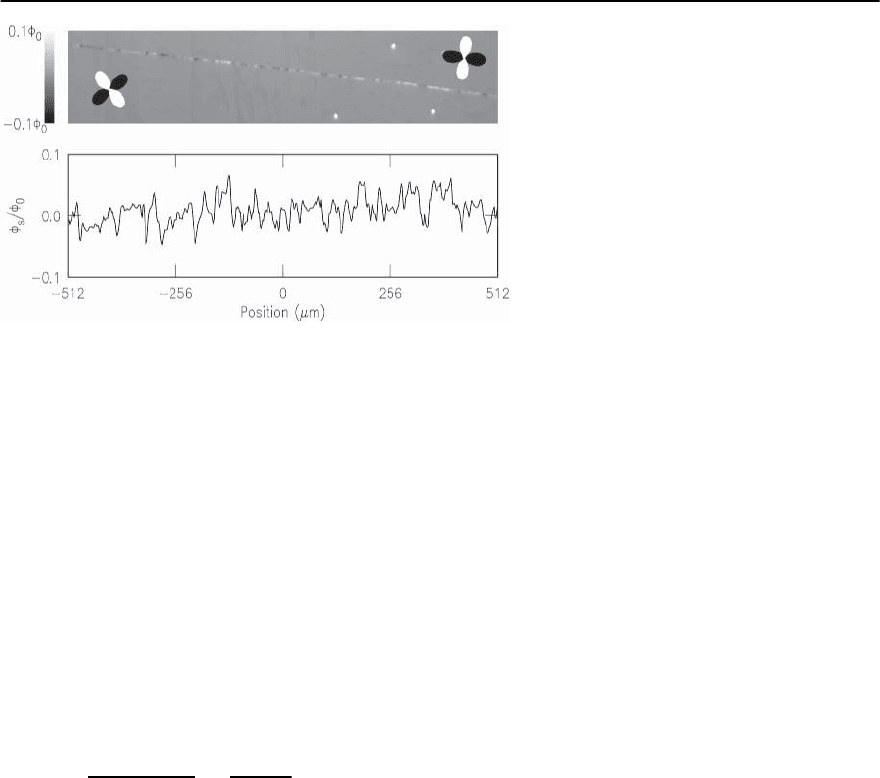
898 C. C. Tsuei and J.R. Kirtley
Fig. 16.26. SQUID microscope image of an
asymmetric 0–45deg YBCO [001] tilt grain
boundary, cooled and imaged in nominal zero
field with a 4 m diameter SQUID pickup loop.
The polar plots indicate the orientation of an
assumed d
x
2
−y
2 gap function on the two sides
of the grain boundary
parallel to the CuO
2
planes. Several interesting ex-
periments have exploited Josephson tunneling along
the c-axis, perpendicular to the CuO
2
planes. As in
basal-plane Josephson tunneling, the magnitude of
the c-axis supercurrent can be estimated from (16.6).
There should be no c-axis pair tunneling between
an s-wave conventional superconductor and a pure
d-wave cuprate superconductor due to an exact can-
celation of the contributions from the positive and
negative lobes of the d-wave gap function. A finite
critical current (I
c
) is expected if the cuprate junc-
tion electrode is a d + s-mixed wave superconductor.
As a reference point, the value of I
c
at T = 0 K for a
tunnel junction between two identical s-wave super-
conductors is given by [177]:
I
c
=
1
2
eR
n
(
1
+
2
)
K
1
−
2
1
+
2
, (16.33)
where R
n
is the normal-state junction resistance,
1
and
2
are the BCS energy gaps of the junction elec-
trodes,and K is the complete elliptic integral.
The observation of a non-zero c-axis supercurrent
in a Pb/YBCO tunnel junction suggests the existence
of an s-wave component of the order parameter in
YBCO. Since second order tunneling [178] has been
ruled out by the absence of half-integer microwave
induced Shapiro steps in such c-axis tunneling ex-
periments [179], the ratio of the experimentally de-
termined value of I
c
R
n
to that predicted by (16.33)
can serve as a measure of the degree of the d + s
admixture in the pair state.
Effects of Twinning
Most of the c-axis tunneling experiments were done
with orthorhombic cuprates such as YBCO and Bi-
2212, which are usually twinned due to the in-plane
anisotropy in the CuO
2
layers, unless they are spe-
cially treated. For example, the twin boundaries in
YBCO run at 45
◦
with respect to the major crystallo-
graphic axes a and b. The two crystal lattice domains
on each side of a twin boundary are related via a mir-
ror reflection symmetry (see Fig. 16.27). In polycrys-
talline YBCO,the spacing between parallel twins can
be as small as 10 nm [34,180].Mostof theYBCO sam-
ples studied in phase-sensitive pairing symmetry ex-
periments were also twinned. However, the fact that
strong evidence for d-wave order parameter symme-
try has been invariably observed in phase-sensitive
experiments with a tetragonal cuprate superconduc-
tor such as Tl-2201 [130,181] and untwinned YBCO
samples [104, 110] make the complications arising
from twinning unimportant to the basic conclusion
of predominantly d-wave pairing symmetry in the
cuprate superconductors. On the other hand, twin-
ning isexpected to playa crucial rolein c-axis Joseph-
son tunneling, especially in determining the value of
I
c
R
n
. To understand the effect of twinning on these
experiments in such heavily twinned samples, it is
extremely important to know how the order param-
eter varies across a single twin boundary in a YBCO
single crystal. There are two alternatives in YBCO
[5,182,183]: (1) The d-wave component of the order
parameter changes sign across the twin boundary,
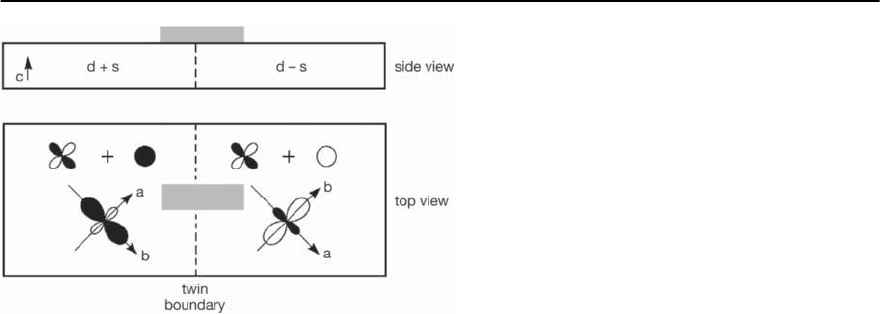
16 Phase-Sensitive Tests of Pairing Symmetry in Cuprate Superconductors 899
Fig. 16.27. Experimental geometry for c-axis tunneling
into a conventional superconductor (Pb) from single
crystal YBCO,with the junction spanning a single twin
boundary. YBCO is an orthorhombic superconductor
with an admixture of d-wave and s-wave pairing sym-
metries. The diagram shows the d
x
2
−y
2 components
with the same phase across the twin boundary, but the
s-wave component with opposite signs across the twin
boundary. There is therefore a change in sign of the
net c-axis coupling across the twin boundary. Adapted
from Kouznetsov et al. [184]
whereas the sign of the s-wave component remains
unchanged; or (2) the converse. The interpretation
of the symmetry experiments with twinned YBCO
single crystals or films depends on which alterna-
tive exists. The fact that a d-wave signature has been
consistently and reproducibly observed in both or-
thorhombic and tetragonal cuprates argues strongly
that the twin boundaries in YBCO have odd reflec-
tion symmetry [182]. The d-wave component of the
order parameter continues across the twin boundary
whereas the s-wave counterpart changes its sign.An
even-reflection twin boundary corresponds to a pre-
dominantly s-wave pair state, which is not observed
in any of the YBCO experiments.
Kouznetsov et al. [184], demonstrated the sign
reversal of the s-wave component across the twin
boundary in a study of a c-axis Josephson tunnel
junction that straddled a single YBCO twin bound-
ary.InFig. 16.27the polar plots of the gap functionin
the twins (top view) represent the mirror reflection
symmetry across the twin boundary (dotted line).
Only the s -wave component changes its sign across
the twin boundary. As a result, the signs of the c-
axis supercurrent switch across the twin boundary.
This is analogous to the Pb/YBCO corner junction
(Wollman et al. [104,105]. When a magnetic field
B is applied parallel to the twin boundary, the field
variation of the critical current I
c
(B) should show a
Fraunhofer pattern with the maximum critical cur-
rent peak shifted to the field value corresponding
to a half-flux quantum. Furthermore, as the angle
between the direction of B and the twin boundary
varies from 0 to 90
◦
, the Fraunhofer pattern I
c
(B)
should gradually recover its standard form. This is
as observed (Fig.16.28).These results provide strong
evidence for a d-wave dominant (d+s) mixed pairing
state in YBCO, and for a sign reversal of the s-wave
component across the twin boundary.Thisfinding is
consistent with the conclusions drawn from all the
phase-sensitive pairing symmetry experiments pre-
sented in the previous sections.
I
c
R
n
-Products
As discussed earlier, the I
c
R
n
-product of a c-axis
Josephson junction can in principle be used as a
measure of the strength of the s-wave component
of the d + s mixed order parameter. In practice, such
a determination is unreliable since I
c
R
n
products of
Pb/YBCO c-axis tunneljunctionsvary from∼1mVto
afew V.For example,the I
c
R
n
products are 1-1.3 mV
for untwinnedYBCO crystals[179]; 0.3–0.9mV [185]
or 0.1–0.3mV [179] for twinned crystals; and ∼10V
for heavily twinned thin films [179,186, 187]. Mi-
crostructural defects at junction interfaces such as
atomic steps and etch pits could give rise to ab
plane tunneling and contribute a random quantity
to the apparent c-axis tunneling current. A system-
atic study of the direction of tunneling in various
Pb/YBCO tunnel junctions seems to have ruled out
such a possibility. The observed large variation can
be dueto twinning.Thec-axistunneling experiments
of Kouznetsov et al. [184] has clearly demonstrated
that the d-wave component is dominant and contin-
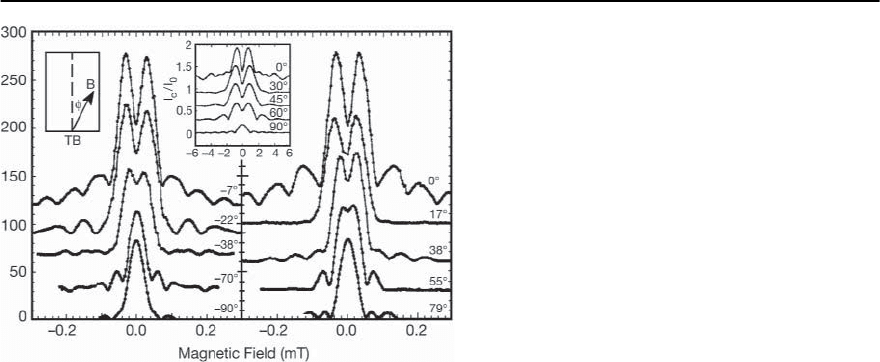
900 C. C. Tsuei and J.R. Kirtley
Fig. 16.28. Josephson interference patterns from the
sample of Fig.16.27,with the magneticfield in the plane
of the junction, as a function of field angle relative to
the twin boundary. These characteristics are consistent
with the pairing phases as diagrammed in Fig. 16.27.
The inset is modeling. Adapted from Kouznetsov et
al.[184]
uous across the twin boundary in YBCO,whereas the
s-wave component changes its sign. Thus the magni-
tude of the I
c
R
n
products in twinned YBCO depends
sensitively on the size and relative distribution of
the d + s and d − s domains, as suggested by several
theoretical studies [80,182,188]. Indeed, this is con-
sistent with the observation that I
c
R
n
products in un-
twinned samples are invariably larger than those of
their untwinned counterparts. The nearly-zero I
c
R
n
products observed in heavily twinned thin film sam-
ples apparently can be attributed to the cancelation
arising from the nearly equal abundance of the two
types of twin domains. Obviously, one needs precise
knowledge of the relative population of the twin do-
mains to quantitatively understand the large scatter
in the I
c
R
n
data.Only data from untwinned junctions
is reliable for an estimateofthestrength of the s-wave
pairing symmetry in YBCO.
AcomparisonofI
c
R
n
values from untwinned
junctions with the Ambegaokar-Baratoff limit
(16.33) provides an estimate of as much as 20% s-
wave component in the d + s admixture for YBCO.
However, estimates from other measurements are
significantly smaller. For example, an upper bound
limit of 10% s-wave was concluded from a study of
the angular magnetic dependence of thermal con-
ductivity in a detwinned YBCO single crystal [68].
A quantitative data analysis of directional tunnel-
ing and Andreev-reflection measurements on YBCO
single crystals indicated a d
x
2
−y
2
-wave dominant gap
parameter with less than 5% s-wave component in
either the d + s or d + is scenarios [189,190].
Vanishingly small I
c
R
n
products (∼afewV)have
been observedin c-axis tunneling between Pb andBi-
2212 [137] or the electron-doped NCCO [155] single
crystals. A d + s mixed pair state is not allowed in
tetragonal NCCO or orthorhombic Bi2212,based on
group theory symmetry arguments (see Sects. 16.1.2
and 16.3.3).Phase-sensitive evidence from tricrystal
experiments (see Sect.16.3.3) with Bi-2212[191] and
NCCO [158] hasshown that bothcupratesare d-wave
superconductors. Thus it is logical to conclude that
the small observed I
c
R
n
product is derived from a
small s-wave component induced at twin-boundary
or junction interfaces, as suggested by several theo-
retical studies [192,193].
c-Axis Twist Junctions
In principle, one can test the order parameter sym-
metry by measuring the angular dependence of
the critical current I
c
() of (001) basal-plane grain
boundary junctions between two identical cuprate
superconductors with a twist angle about the c-axis
direction (see the inset in Fig. 16.29). If the in-plane
momentum is conserved in the c-axis tunneling,
(16.6) leads, for the case of a pure d-wave supercon-
ductor, to
I
c
()=K()
2
0
cos2 , (16.34)
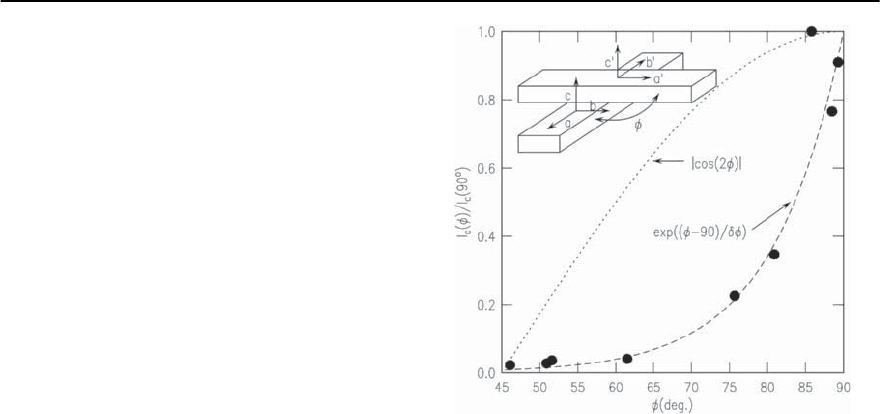
16 Phase-Sensitive Tests of Pairing Symmetry in Cuprate Superconductors 901
where K() is proportional to the -dependent tun-
neling matrix element squared, and
0
is the value of
the d-wave gap in the a, b directions. The parame-
ter K() is not readily determined, but (16.34) pre-
dicts that I
c
≡ 0 for = /4 for d
x
2
−y
2
-wave pair-
ing symmetry. There have been several theoretical
studies [194–203] and experiments [204,205] which
emphasized the importance of including incoherent
(momentum non-conserving) tunneling in the cal-
culation of I
c
(). It has been argued that the con-
dition I
c
( = /4) = 0 should always be satisfied
for a d-wave pair state, regardless of the amount of
coherence in the tunneling processes [203].
The critical currents of c-axis twist junctions have
been measured in the Bi-2212system.Although early
measurements reported a strong dependence of I
c
on [207,208],the results of one group remarkably
showed no angular dependence [209–211]. This has
been taken as evidence against d-wave pairing sym-
metry in Bi-2212. However, these experiments were
done with macroscopic samples with junction areas
∼10
5
m
2
,andcriticalcurrentsof50-150mA[210].In
such experiments the c-axis tunneling currentcan be
limited by local heating, self-field, and bulk critical
current effects, masking the intrinsic -dependence
of I
c
. To clarify these issues, a recent experiment by
Tachiki et al. [206] has repeated the previous ex-
periment [210], with Bi-2212 single crystal whiskers.
The Bi-2212 whisker twist junctions have a junction
area of about 10
3
m
2
and critical currents one to
two orders of magnitude smaller than in the experi-
ments of Li et al. [210]. As shown in Fig. 16.29, I
c
()
is clearly a strong function of the twist angle ,ap-
proaching zero at = /4. In sharp contrast with
the results obtained in a previous experiment [210],
the vanishingly small I
c
R
n
value observed at = /4
is particularly interesting in view of the theoretical
prediction that I
c
R
c
should be zero for d-wave and
finite with no significant angular dependence near
= /4 is expected for the case of an anisotropic
s-wave pair state [203]. Shown as a dotted line in
Fig. 16.29 is the | cos 2 | dependence expected for a
pure d-wave superconductor with no dependence of
the tunneling probabilities on . In-plane tilt grain
boundary junctions in the cuprates show an expo-
nential dependence of the critical current density on
Fig. 16.29.Measureddependenceof the critical current of c-
axis twist grain boundary junctions between single crystal
whiskers of Bi-2212 (solid symbols) [206]. The functional
forms | cos2 | (dotted lin e)ande
−90/ı
(dashed line)are
shown for comparison
misorientation angle J
c
(Ÿ)=C
i
e
−Ÿ/Ÿ
i
with Ÿ
i
∼ 5
◦
for the hole-doped cuprates, and Ÿ
i
∼ 2
◦
for the
electron-doped cuprates [156,157,212]. It is believed
thatthis exponential dependence is dominatedby the
strong dependence of the tunneling matrix elements
on misorientation angle, due to microstructural dis-
order effects [77,213]. The dashed line in Fig. 16.29
shows for comparison a fit of the data to an expo-
nential dependence of the critical current on twist
angle I
c
∼ e
(−90)/ı
,withı =9.3
◦
.The goodagree-
ment between this exponential dependence and ex-
periment makes it appear likely that the observed
angular dependence of I
c
can be explained in terms
of Fermi surface or -dependent tunneling matrix
element effects [203],in a d-wave superconductor,as
opposed to an anisotropic s-wave superconductor.
16.4 Angle-Resolved Determination of Gap
Anisotropy in YBCO
It is clear from the work described so far that an
admixture of d
x
2
−y
2
and s-wave order parameters
is well established in orthorhombic YBCO. Such an
anisotropic d + s pair state is required by the group

902 C. C. Tsuei and J.R. Kirtley
Fig. 16.30. (a) Schematic of two-junction YBCO/Nb rings used for angle-resolved determination of the gap symmetry
in optimally doped YBCO [214]. One ramp edge junction angle was held fixed from ring to ring relative to the YBCO
crystalline a or b axis while the other was varied. (b) Integrated spontaneous flux generated by these rings, as determined
by scanning SQUID microscopy, for a sample with the first junction normal parallel to the majority twin a-axis direction,
as a function of the second junction normal angle () relative to this direction. The solid points are the data; the solid line
is a best fit using a predominant d
x
2
−y
2 component to the gap with a small s component. The dashed line shows much
worse fit results when a small imaginary component is added to the gap functional form
theoretic argument discussed in Sects. 16.1.2 and
16.3.3.The size of this gap anisotropy was measured
recently by locating the nodes in the in-plane gap
function for optimally doped YBCO [214] by mea-
suring the spontaneously generated magnetic flux in
asetof0or-rings with varying junction angles.
This work was based on an experimental configura-
tion originallysuggested fortesting fortime-reversal
symmetry breaking (TRSB) in cuprate superconduc-
tors [215,216].A set of two-junctionYBCO/Nb rings
were fabricatedwith onejunctionnormalangle fixed
relative to a YBCO a or b crystallographic axis while
the second junction normal angle was rotated with
respect to the first in 5 degree or 0.5 degree incre-
ments (see Fig. 16.30) from ring to ring. Arrays of
suchthinfilmYBCO/Nbtwo-junctionringswerefab-
ricated using a ramp-type Josephson junction tech-
nology [217]. The magnetic flux state of these rings,
cooled in various magnetic fields, were imaged at
4.2 K with a scanning SQUID microscope. The spon-
taneously generated flux ¥ in the rings,when cooled
in zero field, alternated systematically as a function
of the second junction angle between nearly zero flux
(N = 0) and the half-flux quantum state ¥ = ¥
0
/2
(N =1/2) in a manner consistent with a predomi-
nantly d
x
2
−y
2
pairing symmetry. The transitions be-
tween the N =0andN =1/2 states occur at angles
slightly different from the (2m+1)45
◦
expected for
apured-wave superconductor, and is in fact con-
sistent with an s/d ratio of 0.1±0.02 (Fig. 16.30). A
three-dimensional rendering of the SSM images of
the rings is presented in Fig.16.31,along with a polar
plot of the corresponding anisotropic d + s pairing
function.A s/d ratio of 0.1 corresponds to a gap mag-
nitude along the b-axis (along the Cu-O chains) di-
rection about20% larger than in the a-axis direction.
This is somewhat smaller than obtained from mea-
surements of the Josephson critical current density
as a function of junction angle in single junctions
produced using the same technology, [218] perhaps
because of incomplete detwinning of theYBCO films
used in the ring samples.
16.5 Universality of the d-Wave Pair State
In two-dimensional strongly correlated electron sys-
tems, especially near the quantum critical point,
phases and phase-transitions abound due to the
competition between various ordered states [219].
The pairing symmetry tests presented so far have
firmly established that the ground state of several
optimally-doped cuprates superconductors has an
order parameter with d
x
2
−y
2
pairing symmetry.How-
ever, there are many theoretical studies that suggest
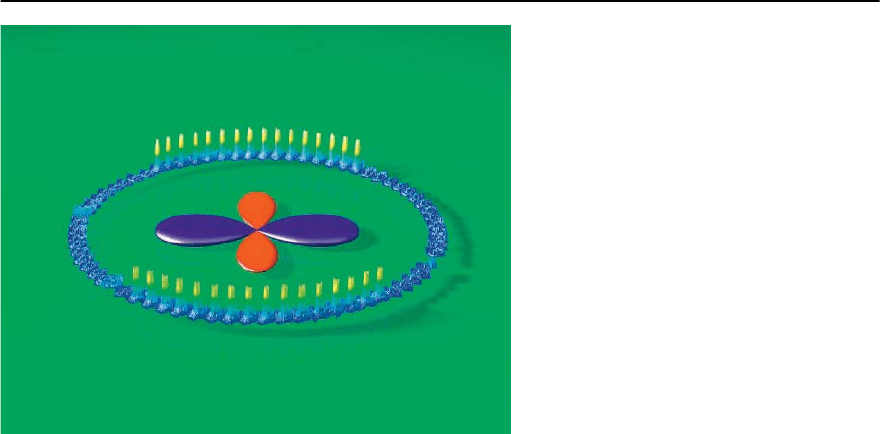
16 Phase-Sensitive Tests of Pairing Symmetry in Cuprate Superconductors 903
Fig. 16.31. Three-dimensional rendering of
scanning SQUID microscope images of 72
YBCO/Nb two-junction rings with one junction
normal angle fixed at −22.5
◦
relative to the ma-
jority twin b-axis and the second junction nor-
mal angle varied in 5
◦
intervals [214]. The rings
were cooled and imaged in zero field. This re-
sulted in rings in either the N =0orN =1/2
flux quantum state, with the transitions at an-
gles slightly different from (2m+1)45
◦
,m an in-
teger, because of a small s component added to
the predominantly d
x
2
−y
2 gap functional form
in optimally doped YBCO
that the d-wave pair state is not stable against var-
ious competing pairing symmetries, depending on
variations in doping, temperature, and time-reversal
symmetry breaking (TRSB) at surfaces and inter-
faces [220–229]. It is therefore important to exper-
imentally determine whether the d-wave state is ro-
bust to a change in these variables.These universality
issues can be investigate bydoing the phase-sensitive
symmetry tests with various cuprates systems at op-
timal doping, and for a given cupratesystem as func-
tions of composition and temperature. Possible evi-
dence for TRSB at the surfaces and interfaces of d-
wave superconductors should also be examined.
16.5.1 Optimally-Doped Cuprates
The bulk of pairing symmetry tests using phase-
sensitive methods was done in various cuprate sys-
tems at optimal doping. A complete list of the
cupratesuperconductors tested (with references) can
be found in a recent review [7].
Hole-doped Cuprates
Evidence for predominantly d-wave pairing has
been found in all the hole-doped cuprate super-
conductors successfully tested using phase-sensitive
methods, including YBCO [87, 104–106, 110, 117],
GdBa
2
Cu
3
O
7−ı
[230], Tl-2201 [130,181], and Bi-2212
[191]. Given a choice between the s-wave and d-
wave pairing channels, a number of numerical stud-
ies have concluded that gap symmetry depends on
band filling and certain band parameters. Based on
the t-t’-J model, with t
/t ≥ −0.4, the d-wave pair
state prevails in a doping range of the band cen-
tered around half-filling, and s-wave pairing sym-
metryismorestableintheunder-andover-doped
regimes [220,222,225].The phase-sensitive evidence
obtainedso far is generally consistent with these con-
clusions: the d-wave channel is favored near half-
filling where T
c
is optimized.
Electron-doped Cuprates
As described in Sect. 16.3.4, strong evidence has
recently been found for d
x
2
−y
2
symmetry in the
T
c
optimized electron-doped cuprate superconduc-
tors NCCO and PCCO from both tricrystal exper-
iments and conventional symmetry probing mea-
surements. It is quite remarkable that the d-wave
pair state predominates in both the electron-doped
and hole-doped cuprate superconductors in spite
of their significant differences in many of the su-
perconducting and normal state properties. On the

904 C. C. Tsuei and J.R. Kirtley
other hands, the observed universal d-wave pair-
ing in cuprate superconductors is not unexpected,
because the basic theoretical models for describ-
ing high-temperature superconductivity,such as the
one-band Hubbard model and its large-U limit, the
t-J model, are all intrinsically electron-hole sym-
metrical [231]. Electron-hole asymmetry can be in-
corporated into various t − t
− J models [232,233]
and three-band Hubbard models [234]. For example,
the differences in doping characteristics between the
electron- and hole-doped cuprates can be explained
in terms of band structureeffects based on a t −t
−J
model [233] or a three-band Hubbard model [235].
However, this feat and more can be accomplished
by taking into account the different dispersions for
the two types of charge carriers, and by using an ef-
fective one-band Hubbard model [236]. Therefore, it
appears that the apparent electron-hole asymmetry,
as manifested in many anomalous properties, stems
largely fromband structure effectsand is not relevant
in determining pairing symmetry. This finding and
the small in-plane coherence length (∼20Å) charac-
teristic to all cuprate superconductors, suggests that
the universal d-wave pairing occurs on a relatively
local scale.
16.5.2 Extended s-Wave Pair State
As mentioned in Sect. 16.2, there has been an enor-
mous amount of work on tests of the pairing sym-
metry in the cuprate superconductors using various
phase insensitive techniques [4, 5, 7]. Although this
work has resulted in a general consensus that the
pairing wavefunction has lines of nodes, these tech-
niques, with the exception of angle resolved pho-
toemission, are relatively insensitive to the momen-
tum dependence of the nodal structure. This makes
it difficult for them to distinguish, for example, be-
tween d
x
2
−y
2
symmetry (with four lines of nodes),
and extended s-wave symmetry (with eight lines of
nodes). There has recently been support for the lat-
ter symmetry from analysis of various phase insen-
sitive tests of pairing symmetry [237,238]. These au-
thors attempt to reconcile this conclusion with the
phase-sensitive experiments, which definitively fa-
vor d
x
y
−y
2
symmetry,by arguing that the cuprates can
have different bulk and surface symmetries [192].In
this view the phase-insensitive techniques probe the
bulk extended s-wave symmetry, while the phase-
sensitive techniques,which depend on surface sensi-
tive Josephson tunneling,probed-wavepairing sym-
metry.
This view seems untenable for several reasons.
First, the consistency of the tricrystal experiments
[7], both in that samples with a -ring geometry for
a d-wave superconductor always show the half-flux
quantum effect,andthat the half-fluxquantumeffect
can be turned on and off by changing the tricrystal
geometry in a way that is consistent with d
x
2
−y
2
pair-
ingsymmetry,makeitappear extremelyunlikelythat
these experiments are controlled by surface effects.
Second, the tricrystal experiments have shown that
the half-flux quantum effect persists,with no change
in the total flux within experimental accuracy, to
withina degree of T
c
[239].At these temperatures the
ab plane coherence length can be ten times the unit
cell dimension, meaning that these experiments are
not surface sensitive but rather probe the order pa-
rameter deeply into the bulk: nevertheless the results
strongly favor d-wave pairing symmetry.Further,al-
though the I
c
R
n
product forthegrainboundary junc-
tions used in the tricrystal experiments are relatively
small, experiments with -SQUIDs and facetted -
junctions in YBCO-Nb ramp junctions produce con-
vincing evidence for d-wave symmetry with junc-
tion I
c
R
n
products within a factor of four of the
Ambegaokar–Baratoff limit [174–176]. This means
that the superconducting gap is not significantly re-
duced by surface effects in these samples.
The tetracrystal experiments [130] have provided
strong evidence for pure d-wave pairing symmetry
in tetragonal Tl-2201. It also rules out anisotropic s-
wave pairing symmetry.The tetragonal crystal struc-
ture of the Tl-2201 epitaxial films used in this ex-
periment were checked and confirmed with three
techniques for microstructural analysis [130]. It is
well established that Tl-2201 can be fabricated with
either orthorhombic or tetragonal crystal structure
with identical superconducting properties (includ-
ing T
c
∼80 K) [240–242]. Furthermore, it has been
shown that there is no temperature-dependent struc-
tural phase transition in the temperature range

16 Phase-Sensitive Tests of Pairing Symmetry in Cuprate Superconductors 905
50(well below T
c
)–300 K in either form of Tl-2201.
This observation, as well as the results of neutron
scattering and x-ray diffraction, leads to the conclu-
sion that the orthorhombic to tetragonal structure
change is due to static compositional effects, and is
not driven by any thermal structural instability.
The combination of the observations above lead
us to conclude with confidence that the pairing sym-
metry in the cupratesuperconductors hasd
x
2
−y
2
sym-
metry, and not the extended s-wave symmetry.
16.5.3 The Effect of Doping
The competitionbetween pairing symmetries in var-
ious superconducting cuprate systems as a func-
tion of doping has been emphasized repeatedly
[219,220,222,223,225,243–246].In particular,a tran-
sition from a d to an s-wave pair state induced by a
change in doping has been suggested. For references,
see Sect. 16.4. The tricrystal pairing symmetry test is
especially well adapted for a systematic study of the
effect of doping on pairing symmetry.
Recently, we have carried out a series of tricrystal
experiments with a c-axis oriented Bi-2212 tricrys-
tal thin-film sample as a function of doping [247].
The systematic pairing symmetry study started with
an over-doped Bi-2212 tricrystal sample with a T
c
of 69 K. The doping level was then reduced by an-
nealing the sample in flowing Argon at tempera-
tures between 350 C and 420 C for various lengths
of time to achieve an optimum T
c
of 82 K and a
T
c
of 40 K in the under-doped regime. The half-flux
quantum effect at the tricrystal point was monitored
as a function of such annealing. The d-wave pairing
symmetry was found to persist throughout the entire
doping range studied so far. There are also similar
phase-sensitive evidences for d-wave pairing sym-
metry in both the under-doped and over-doped Tl-
2201 samples, overdoped Y
0.7
Ca
0.3
Ba
2
Cu
3
O
7−ı
,and
underdoped La
1.85
Sr
0.15
CuO
y
[247].A possible d
x
2
−y
2
to d
x
2
−y
2
+ s symmetry transition in Ca-doped YBCO
has been reported [248].
In addition to the tricrystal experiments, mea-
surements of low-temperature thermal conductiv-
ity [249,250] have provided strong evidence in sup-
port of a d-wave pair state that prevails throughout
the entire phase diagram from underdoped to over-
doped regimes for several cuprate systems.
16.5.4 Temperature Dependence
In view of the possible changes in pairing symmetry
as a function of temperature [222,223,225,251–253],
it is important to experimentally determine the tem-
perature dependence of the pairing symmetry in a
d-wave superconductor such as YBCO. It is diffi-
cult to study the temperature variation of the pair-
ing symmetry in an unconventional superconduc-
tor using conventionaltechniques,sincethey become
obscured by thermal excitations at higher tempera-
tures. Phase-sensitive pairing symmetry probes that
employ Josephson pair tunneling are in principle
immune to thermal broadening. In practice most
of these techniques also fail at higher temperatures
because they depend on tunneling into low-T
c
su-
perconductors [104–106,110]. Only phase-sensitive
symmetry tests, such as the tricrystal experiments,
which use all-cuprate grain boundary Josephson
junctions can be used for determining pairing sym-
metry atall temperatures below T
c
.Kirtley etal.[239]
used a variable sample temperature scanning SQUID
microscope [254] to measure the total spontaneous
flux at the tricrystal point of a YBCO thin film in a
frustrated tricrystal geometry as a function of tem-
perature. With this microscope the tricrystal sam-
ple was heated to different temperatures while the
SQUID sensor was kept below its superconducting
temperature of ∼9 K. Shown in Fig. 16.32 are scan-
ning SQUID microscopy images of the d-wavesigna-
ture, the half-flux quantum, at the tricrystal point at
selected temperatures.
These experiments showed that the half-integer
flux quantum effect at the tricrystal meeting point
persists from T =0.5KthroughT
c
(∼90 K).Careful
modeling (Fig.16.33)showed that the totalflux in the
half-vortex was equal to ¥
0
/2 to within experimental
errors at all temperatures. This implies that d-wave
pairing symmetry dominates in this cuprate,with no
observable time-reversal symmetry breaking, over
the entire temperature range.
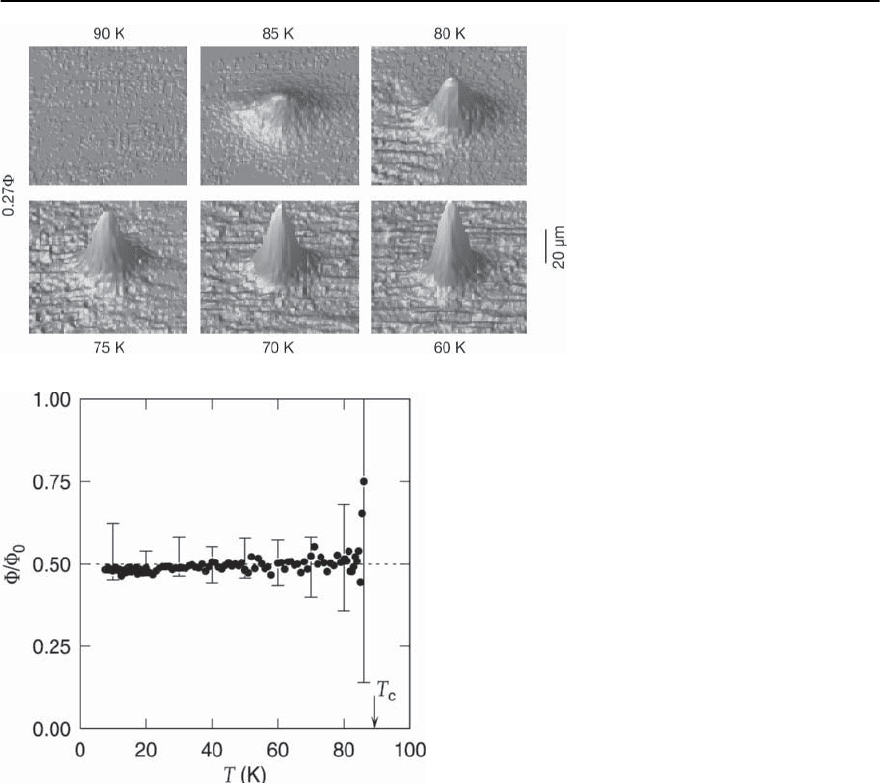
906 C. C. Tsuei and J.R. Kirtley
Fig. 16.32.Scanning SQUID microscope
images of the development with tem-
perature of the half-flux quantum vor-
tex at the tricrystal point for a thin film
sample of YBCO in a geometry designed
to be a -ring for a d-wave supercon-
ductor
Fig. 16.33. Best fit values for the total magnetic flux spon-
taneously generated at the tricrystal point of a YBCO thin-
film sample in a tricrystal geometry designed to be frus-
trated fora d
x
2
−y
2 superconductor, as a function of temper-
ature. To within the experimental uncertainties, the total
flux is ¥
0
/2from0.5KtoT
c
∼ 90 K. This indicates that
d-wave pairing symmetry dominates at all temperatures,
with little (if any) imaginary component, in YBCO
16.5.5 Time-Reversal Symmetry Breaking
It has been suggested that as temperature decreases
below a certain characteristic value, a pure d-wave
pair state is not stable against the formation of
mixed pair states such as d
x
2
−y
2
+ is or d
x
2
−y
2
+ id
xy
[129, 251, 255–261]. Due to the coupling between
the two subcomponents of the order parameter, the
mixed pair state is fully-gapped, much like that in
an s-wave superconductor [251, 257]. The power-
law temperature dependence of observables such as
specific heat, thermal conductivity, and penetration
depth characteristic of d-wave superconductors re-
verts to the exponential behavior typical for s-wave
superconductors. Measurements of the penetration
depth of Zn substituted LSCO [262] shows that it
retains a T
2
dependence, indicative of d-wave pair-
ing in the presence of scattering, until T
c
is sup-
pressed to zero. This argues against an admixture
of s-wave pairing at any T
c
. There has been a report
of a temperature-dependent time reversal symme-
try broken pair state (i.e. d
x
2
−y
2
+ is state) in YBCO
near T
c
[263]. Furthermore, there is thermal trans-
port evidence suggesting thata phasetransition from
apured
x
2
−y
2
-wave state into time-reversal symmetry
broken states such as d + is or d
x
2
−y
2
+ id
xy
can be
induced in Bi-2212 at low temperatures by magnetic
field [264] or by magnetic impurities [265]. How-
ever, there are new experiments [266–268] and cal-
culations [269] indicating the interpretation of the
original experiments are much more involved.
Further, it has been shown theoretically that bro-
ken time-reversal symmetry could occur locally in
a d
x
2
−y
2
superconductor at certain surfaces and in-
terfaces, or in the presence of magnetic impurities
[270–277]. Evidence for broken time reversal sym-
metry in YBCO has been observed from the splitting

16 Phase-Sensitive Tests of Pairing Symmetry in Cuprate Superconductors 907
of the zero bias conductance peak (ZBCP) induced
by the Andreev surface bound states [154,278,279],
and by a small spontaneous magnetization at the su-
perconducting transition [280].
A ZBCP in the quasiparticle tunneling spec-
trum, due to the formation of zero-energy Andreev-
bound states associated with sign changes across
the nodes of the k dependent order parameter, can
be used as a signature for d-wave pairing symme-
try [57,58,281,282].A split in the ZBCP is expected
in the presence of TRSB in mixed pair states such as
d
x
2
−y
2
+ is or d
x
2
−y
2
+ id
xy
[283]. Recent theoretical
treatments have pointed out that there are possibili-
ties other than TRSB that can lead to ZBCP splitting
in pure d-wave superconductors[284,285].
In thetricrystal experiments withYBCO [119] and
Tl-2201 [181], the applied flux needed to nullify the
SQUID difference signal in the three-junction ring
was always found to be within 3% of ¥
0
/2. Tricrystal
experiments with electron-doped NCCO and PCCO
at 4.2 [158] and YBCO at temperatures close to T
c
[239] have all demonstrated that the total amount of
flux spontaneously generated at the tricrystal point
remains the same (within the experimental accu-
racy of ∼ 3%), regardless of which of the two time-
reversed half-flux quantum states the tricrystal sam-
ple is in. All these observations imply that the gauge-
invariant phase shift as defined in (16.5) is very close
to , in turn suggesting that any out-of-phase com-
ponent of the order parameter must have an ampli-
tude less than a few percent of the primary compo-
nent. Such a mixed pair state (e.g. d + is) would lead
to a phase shift 0 <
J
< ,and also a fractionalflux
quantum x¥
0
with 0 < x < 1/2 [80,193].
The observation of total flux different from ¥
0
/2
in the multi-crystal experiments in a ring geome-
try would not necessarily imply broken time reversal
symmetry. As seen in Fig. 16.5, if the LI
c
product is
not sufficiently largecomparedwith ¥
0
,then the total
flux in a ring geometry will be less than ¥
0
/2. For ex-
ample, in a tricrystal experiment with Tl-2201 [181],
in which the I
c
L product was low, and the amount
of the spontaneously generated flux through the ring
was indeed noticeably smaller than
1
2
¥
0
(x ∼ 0.3).
However, multi-crystal experiments in a blanket film
geometry have always been done with the sample size
much larger than the Josephson penetration depth
J
. In this case, the total flux in the Josephson vortex
at the multi-crystal point in a frustrated geometry
should be exactly ¥
0
/2. Mathai et al.[106] estimated
that the time-reversal symmetry breaking compo-
nent of the pairing order parameter was less than
5%, in agreement with the conclusions by Kirtley et
al.[119]from“magnetic titration”of a tricrystalring.
Recent studies on the magnetic field modulation of
critical currents in grain boundary junctions [286]
and-SQUIDs[176]haveproducedsimilarevidence
against TRSB at the junction interface.
Tafuri and Kirtley [287] have found evidence for
spontaneous magnetization, associated with the su-
perconducting transition, that appears to be corre-
lated with defects in some c-axis orientedYBCO thin
films.The association of spontaneous magnetization
with defects could help to explain why evidence for
time-reversal symmetry breaking is seen in some
samples, using some techniques, but not in others.
16.6 Implications of d-Wave Pairing
Symmetry
The implications of d
x
2
−y
2
-wave pairing symmetry
for understanding HTS and for its applications are
numerous. Due to space limitations, we shall briefly
discuss only some of the topics here.
16.6.1 Universal d-Wave P air State in Cuprates
The phase-sensitive experiments, as presented in
Sects. 16.3 and 16.4 above, augmented with sev-
eral conventional order parameter symmetry prob-
ing techniques, have established the predominance
of d
x
2
−y
2
-wave pairing symmetry in both the hole-
and electron-doped cuprate superconductors. The
tricrystal and tetracrystal experiments have also
provided phase-sensitive evidence, based on group-
theoretic symmetry arguments, for the existence
of a pure d-wave state in Bi-2212 and Tl-2201
(Sect. 16.3.3). Furthermore, a series of tricrystal ex-
periments have also demonstrated that the d-wave
pair state in several high-T
c
cuprate superconduc-
tors persists in spite of deviations from optimal dop-
ing (Sect. 16.4), and variation in temperature over
